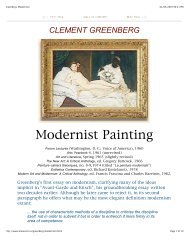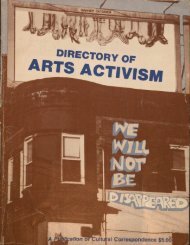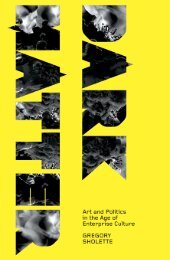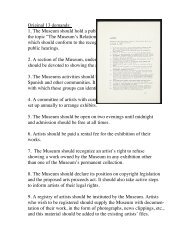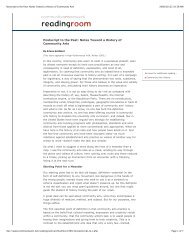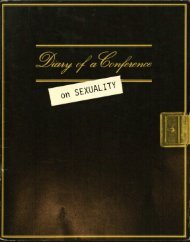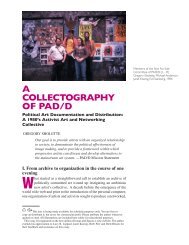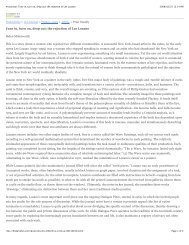Screen - Dark Matter Archives
Screen - Dark Matter Archives
Screen - Dark Matter Archives
Create successful ePaper yourself
Turn your PDF publications into a flip-book with our unique Google optimized e-Paper software.
309 C MacCabe.<strong>Screen</strong>, op cit.p 36.ings does it open on to? It means nothing precise. nothing maintainable:it opens on to three phrases. 'fille des nuits de PaulNiquet, des mysteres de Paris et des caucbemars d'Edgar Poe',A working girl from the faubourgs/a woman from the farthestedges of fa prostitution populaire clandestine, soliciting the favoursof chiffonniers (one might reasonably ask: With a black maidbringing in a tribute of flowers? Looking like this, with theseaccessories, this decor, this imperious presentation of self?)/acharacter out of Eugene Sue 's melodramatic novel of the city'slower depths/a creature from Edgar Allen Poe. The shifts aremotivated clearly, but it is thoroughly unclear what the motivationis : the moves are too rapid and abrupt, they fail to confirmeach other's sense - or even to intimate some one thing, t ooelusive to be caught directly, but to which the various metaphorsof the text all tend.The identification of class is not a brake on meaning: it is thetrigger, once again, of a sequence of connotat.ions which do not addup, which fail to circle back on themselves, declaring their meaningevident and uniform. It may be that we are too eager, now, topoint to the ill usory quality of that circling back. that closureagainst· the 'free play of the signifier'. Illusion or not, it seemsto me the necessary ground on which meanings can be establishedand maintained : kept in being long enough, and endowed withenough co herence, for the ensuing work of dispersal and contradictionto be seen [Q matter - to have matter, in the text, towork against.VNashville articulates American politics and music in the space ofcinema, and that articulation can only be understood by mobilisinga heterogeneous set of knowledges (both cinematic and ideological)which will provide the specific analysis. Insofar as theknowledges we mobilise are, of necessity, heterogeneous, therecatl be no question that the reading produced is exhaustive.Between the alternatives of the formalist dream of the rea ding andthe voluntarist nightmare of my/our reading, both of whichexhaust the film' s significance, a materialist read ing specifiesarticulations within the film on determinate grounds.!)My questions about this passage would be: what determineswhich set of 'knowledges' are mobilised? Is there some means bywhich we can test which readings are, if not exhaustive, at leastappropriate? What is meant by 'determinate' in the last sentence?I suppose it will be obvious that my reading of Olympia will beproduced as a function of the analysis of its first readings: I donot claim that this gives it some kind of objectivity. or even someprivileged status 'within historical materialism'. But it providesthe reading with certain tests of appropriateness, or, to put itanother way. it presents the reading with a set of particular questions to answer, which have been produced as part of historical enquiry. (I do not object to the formula 'historian's practice' here. as long as we are free to debate whether there are some practices of knowledge with more articulated notions of evidence, t est ing and 'matching' than others.) My reading of Olympia would address the question: what is itin the image which produces, or helps produce, the critical silenceand uncertainty I have just described? What is it that induces thisinterminable displacement and conversion of meanings? I wouldlike. ideally. to give the answer to those questions an interleaved,almost a scholiastic form, tying my description back and back tothe terms of the critics' perplexity, and its blocked. unwilling insightinto its own causes. Clearly, the reading would hinge onOlympia's handling of sexuality. and its relation to the traditionof the nude. (It would also have to deal with its relation to a newand distinctive sub-set of that tradition: the burlesque and comicrefutation of the nude's conventions set in train by Courbet in the1850s. There is no doubt that the critics in 1'865 ~vanted Olympiato be part of that sub-set, whose terms they approximately understood.if only to abhor them; and there are ways in which thepicture does rela te to Courber's Realism. A painting of a prostitutein 1865 inevitably bore comparison with Courber's Demoisellesde la Seine or Venus Capitonnee; a comparison of subject-matter,obviously, but also of modes of address co the viewer, fo rms ofdisobedience to that 'p lacing of the spectator in a position ofimaginary knowledge' which was the nude's most delicate achievement.)I shall give some element .of the reading here.VIWe might approach the problem by asking. would it do to describethe disposition of signs in Olympia as producing some kind (variousforms) of ambiguity? The things I shall point out in the image mayseem at first sight nothing very different from this. And the wordwould provide us with a familiar critical comfort, since it seemsto legitimise the position of the a-historical 'interpreter' and allowthe open, endless procession of possible meanings to be the verynature of [he text, the way art (, li terature') works, as opposed tomere practical discourse. I do no t agree with that ethic of criticism,or the art practice it subtends. On the contrary. it seems to methat ambiguity is only functional in the text "...hen a certai n hierarchyof meanings is established and agree9 on, between text andreader - whether it be a hierarchy of exoteric and eso.reric, orcommon-sense and 'contrary', or narrative discourse and non31



